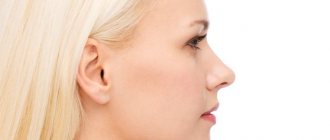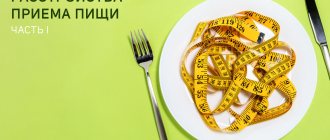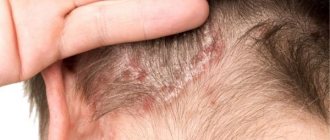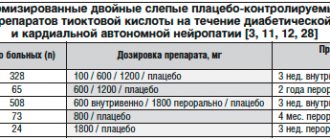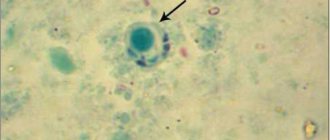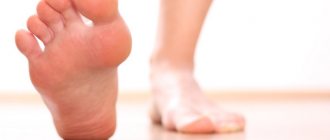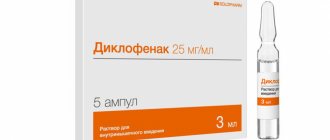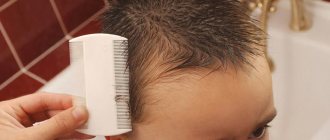Symptoms and clinical picture of ascariasis in children
If the number of worms entering the body is small, the disease may occur in an unexpressed form.
At an early stage, the following manifestations of ascariasis in children may be observed (associated with the penetration of larvae into the lungs and liver):
- deterioration in general health;
- temperature rise to 38 C;
- heavy sweating;
- pain in muscles and joints;
- nausea, vomiting, loss of appetite;
- swelling of the eyelids and face;
- cough is dry or with mucous sputum streaked with blood;
- difficulty wheezing, wheezing;
- chest pain;
- dyspnea;
- suffocation;
- allergic reaction (urticaria);
- skin itching;
- enlargement of lymph nodes, liver and spleen.
Symptoms of ascariasis in children at the second stage - intestinal:
- bloating and flatulence, pale skin or mild jaundice,
- abdominal pain, most often in the umbilical area,
- constipation or loose stools, weight loss.
Further development of the disease leads to a significant weakening of the immune system and the development of serious complications.
Causes
The cause of ascariasis is the introduction of helminth eggs into the gastrointestinal tract. The source of infection is a sick person. It releases ascaris eggs with feces, which fall into the ground and mature there. This requires suitable climatic conditions: temperature, humidity, air circulation. There is a correspondence between the rate of development of larvae in the egg and temperature:
- 15-30 °C – ripening occurs in 9-42 days;
- 24-30 °C – 16-18 days.
At temperatures below 12 °C, eggs do not develop, but they are able to wait out an unfavorable period, while they remain viable throughout the year.
Transmission routes
The transmission mechanism is fecal-oral. It is carried out through household items, water or food products. A child can become infected after eating unwashed vegetables, fruits or poor-quality drinking water. Children play in the sandbox, garden, and playgrounds. There they contaminate their hands, which also become a transmission factor.
Ascariasis is more common among residents of rural areas. People suffer from it throughout the year, but a significant number of cases are observed in the fall, when berries and vegetables ripen. In winter, they are stored in pantries and cellars, where favorable conditions for the maturation of eggs are also created.
Characteristics of the pathogen
Ascaris parasitizes not only humans, but also pigs. This worm is yellowish-red in color, but after death it turns white. It is similar in shape to a spindle, the body length is different in females and males. The former are much larger (25-40 cm in length) and can lay up to 250 thousand eggs. The lifespan of one individual is 1 year. Parasites are classified as geohelminths due to the need to mature in the soil.
Migration of roundworms
The appearance of roundworm eggs in the intestines is the first stage of the disease. The larvae are released from their shells and enter the blood vessels, through which they are transported to the liver and lungs. Other localizations are also possible: eyes, brain, kidneys, but they occur less frequently. In the lungs, through small bronchioles and alveoli, the larvae enter the respiratory tract, rising to the pharynx. There they are reintroduced into the digestive tract. Migration lasts about two weeks. Then the larvae fully develop in the intestine, and reach sexual maturity in 70-75 days.
Roundworms are very mobile and aggressive. They can rise and fall along the intestines. Adults injure the intestinal wall, forming fistulas and causing purulent complications. Large accumulations of roundworms lead to intestinal obstruction, and toxins and their metabolic products lead to allergic reactions.
Diagnostic methods
Diagnosis of ascariasis in children is based on clinical and epidemiological data. In the intestinal stage, the diagnosis is made by the presence of eggs or roundworms in the feces.
Basic tests for ascariasis in children:
- complete blood count (shows the presence of leukocytosis and eosinophilia);
- microscopic sputum smear (detects the presence of larvae);
- stool analysis for worm eggs.
X-rays of the intestines and chest, endoscopic studies can reveal adult roundworms.
Prevention of ascariasis
Infection with roundworms most often occurs in children's groups in the spring and summer during walks and games in nature. The danger of the consequences of this disease cannot be underestimated. Therefore, parents need to teach their children the rules of personal hygiene as early as possible. It is also necessary to monitor the quality of baby food and strengthen general immunity. As a preventive measure, it is necessary to regularly carry out preventive deworming.
Dear parents!
Remember that only a qualified pediatrician can make an accurate diagnosis, determine the causes and nature of the disease, and prescribe effective treatment. You can make an appointment with our specialists or call a doctor at home by calling 8-800-700-31-69 Grow up healthy and happy!
Basic treatment methods and contraindications
Ascariasis can only be treated with medication.
In the acute phase, desensitizing and anthelmintic drugs are used - Thiabendazole or Mebendazole. Bronchodilators and corticosteroids are also prescribed to relieve pulmonary manifestations.
In the intestinal stage, Levamisole or Pyrantel is used once, as well as multivitamins, iron supplements, and enzyme preparations.
Usually the disease is completely cured. A month later, a control stool test is prescribed (done three times).
Dietary recommendations for the treatment of helminthiasis
Excessive consumption of sweets and dairy contributes to the proliferation of worms. Therefore, during treatment it is necessary to exclude sweets, chocolate, cakes, and milk from the child’s diet. Fermented milk products are useful - kefir, fermented baked milk. It is extremely important to get more fiber in your diet, which has a beneficial effect on intestinal function. It is found in sufficient quantities in foods such as wholemeal bread, fruits, and vegetables. The diet also includes foods containing vitamins A, B, C. These are liver, especially sea fish, egg yolk, cream, butter, fish oil, peas, walnuts. The fruits of sea buckthorn, rose hips, black currants, and red pepper contain large quantities of vitamin C.
Among plant products, garlic, strawberries, apricot kernels, ripe melon juice grown without chemicals, raw carrots and their seeds, watermelon and pumpkin seeds, walnuts, pomegranate juice and St. John's wort tea have good anthelmintic properties. This will help get rid of worms, in addition to the special tablets that the pediatric gastroenterologist will prescribe.
When treating giardiasis, whole milk and foods containing gluten (baked goods and pasta, all cereals except rice, buckwheat and corn) are excluded from the child’s diet. Sour drinks (cranberry, lingonberry fruit drinks, tea with lemon, kefir), boiled meat, fish, vegetable side dishes are recommended.
Preventive actions
So, you need to wash your hands every time after walking, visiting the toilet, and before eating. In addition, the child must have trimmed nails, a neat appearance, and clean underwear. Each person must have their own bed and their own towel. It is also necessary to thoroughly wash vegetables and fruits, and heat process meat and fish.
It is recommended that all family members be periodically examined by a doctor and regularly carry out preventive deworming for pets.
Treatment or drug prophylaxis will be prescribed by a pediatric gastroenterologist. The basis for prescribing any drug to a child of any age should be test results and a conversation with parents.
Services and prices
Primary appointment (examination, consultation) with a gastroenterologist
2,200 rub.
Repeated appointment (examination, consultation) with a gastroenterologist
2,100 rub.
Fecal occult blood test
390 rub.
Stool examinations: Stool analysis for protozoa and helminth eggs
440 rub.
Stool tests: Test for enterobiasis
440 rub.
Giardia Lamblia, cal
410 rub.
Treatment with folk remedies
With the availability of effective medications, the need for folk remedies has disappeared. But some parents continue to insist on using:
- mashed pumpkin seeds, washed down with boiled water;
- onion infusion (pour hot water over the chopped onion and leave for 12 hours);
- collecting herbs from chamomile, wormwood, tansy flowers, brewed with boiling water, the decoction has a rather unpleasant and bitter taste, it will be difficult to force a child to drink it;
- A decoction of walnut leaves has a much more tolerable taste.
Walnut leaves can be used for therapy
According to the recommendations of folk sources, every evening the child needs to be given cleansing enemas to remove dead and weakened worms. Even traditional healers consider tincture of celandine and garlic to be contraindicated for children.
How to take a stool test for ascariasis?
No special preparation is required. But some recommendations will have to be taken into account:
- Before collecting stool for ascariasis, both children and adults need to go to the toilet and urinate.
- Then you need to take a clean, dry container (pharmacies sell special plastic containers designed for collecting feces, as they look like in the photo). If you don't have any on hand, any empty bottle with a lid will do.
- To determine ascariasis, it is necessary to place a volume of material equal to two teaspoons in a container.
- It is necessary to take samples from different sides of the feces (side, bottom, inside).
- After immersion in the container, the material is tightly closed with a lid.
- It is important to stick a piece of paper on the container with the inscription of the last name, first name and date of collection of the analysis.
In order to make an accurate analysis of stool, the material cannot be stored in a container for a long time (ideally, the time difference between collection and laboratory examination should be no more than 45 minutes). If necessary, you can delay the time for five to six hours, but for this it is best to put the feces in the refrigerator.
Traditional medicine methods demonstrate good effectiveness in treating ascariasis. Particularly popular is the juice obtained from pumpkin seeds. It is recommended to drink it daily on an empty stomach. You can also take garlic diluted with milk.
The causative agent of the disease is nematode worms
This type of helminthiasis is caused by a round nematode from the Ascarididae family. Human roundworm provokes an anthropotic disease, which in terms of distribution is in second place among parasitic diseases (enterobiasis is in first place). The disease ascariasis is caused by the bisexual helminth pathogen Ascaris lumbricoides, which has a spindle-shaped shape and a yellow-reddish color. Mature males with a characteristic curving tail are less wide than females (up to 6 mm), measuring 25-15 cm, females up to 40 cm long. The eggs are oval, large, brown and colorless, with a shell that has two contours.
In the human body, worms are localized primarily in the small intestine, where they can live for 1-2 years and remain, continuously moving opposite the food bolus. Parasites are capable of laying 200 thousand non-invasive eggs every day. They, as well as dead individuals, are released into the external environment with fecal matter, where they undergo an incubation period (12-15 days) until the invasive stage or are stored under unfavorable climatic conditions. An infective egg (that is, capable of causing the acute phase of the disease) develops into a sexually mature worm during a cycle lasting 2-3 months.
Ascaris eggs
Conditions favorable for the maturation of parasites, the causes of ascariasis, are an ambient temperature of about +25°C to +30°C, humid air and soil. Developing for about two weeks, the larva reaches the mature phase and migrates for 10-12 days. The ovulation period (the release of eggs) lasts until the seventh month of parasitism. The time from egg invasion into the human body to development into a sexually mature individual is approximately 8 weeks. At each stage of ascariasis, the parasite in all phases of development causes dangerous symptoms.
Complications caused by roundworm infestation
Complications of ascariasis are one of the greatest dangers associated with the disease. When parasites enter the body, they often destroy postoperative sutures and lead to difficult childbirth. A common complication is intestinal obstruction, spasms due to clogging of the lumens by clusters of helminths. At the same time, the nerve endings are irritated, which leads to swelling of the abdominal walls and vomiting due to intoxication. When intestinal walls break through or nematodes penetrate the pancreas, acute pancreatitis develops, characterized by “dagger-like” pain in the upper abdomen.
ascariasis complications
Other complications of the disease are:
- obstructive jaundice of the skin and eye sclera, heaviness in the hypochondrium on the right side, impaired absorption of fats;
- abscesses due to the penetration of helminths through the portal veins into the liver and damage to the mucous membranes and tissues of the organ;
- pneumonia and asphyxia - with pulmonary damage in the alveoli, an inflammatory process develops, manifested by increased breathing, hyperthermia, reflex spasms due to damage to the mucous membranes by parasites, a painful cough until breathing stops;
- purulent cholecystitis and cholangitis - if the worms affect the biliary tract, patients suffer from chills, severe pain in the hypochondrium (right);
- disorders of the central nervous system and mental disorders - nervous diseases, tics, epileptic seizures, severe irritability;
- sepsis, peritonitis and appendicitis - massive infection leads to life-threatening consequences and requires immediate surgical attention.
Complications are provoked by the motor activity of worms, which can also be localized in organs and areas of the body that are atypical for themselves. In addition to the characteristic cough, hyperthermia, asthmatic syndromes, abdominal pain, ascariasis is sometimes manifested by inflammation of the genitourinary system, middle ear (otitis), lacrimal canals, and associated intestinal infections. Parasites can also penetrate into the sinuses, where they die and, if discovered, it is by accident. Diagnosis of ascariasis is always difficult and requires multidirectional studies.
symptoms of ascariasis in the intestines
Effective treatment - complex anthelmintic effect and restoration of the body
Parasitic intoxication, which entails weakened immunity, exacerbation of chronic diseases and other problems, is caused simultaneously by several reasons. Roundworms absorb nutrients from the body (first of all, helminths reduce the amount of microelements), and their deficiency leads to human poisoning with toxic heavy metals. Their antagonists are trace elements (zinc, selenium, copper, iodine, manganese, and so on). Therefore, the only effective approach can be considered to be one focused on the simultaneous fight against helminths and the replenishment of vital substances, supported by regular and systematic drug administration in courses.
Patients with ascariasis need antiparasitic complexes, the components of which eliminate pathogenic factors, reduce the formation of oxidation products and affect inflammatory infections. Preparations from NPK Optisalt have the necessary antibacterial and anthelmintic properties. The complexes are certified and clinically tested at the Institute of Biology named after. N.K. Koltsov at the Russian Academy of Sciences. They contain anthelmintic components of natural origin that do not have a toxic effect (licorice, tansy, horsetail and others), as well as key microelements. They are necessary for the body to recover from helminthic diseases and return the body to all vital functions.
ANTIPARASITIC COMPLEXPrice: 2,730 RUB.
The anthelmintic program includes drugs:
- "Metosept plus";
- "Vitanorm plus";
- "Bactrum";
- "Regesol";
- "Tsimed";
- "Maxifam Plus";
- "Imcap" or "Fomidan", depending on the symptoms.
Each of the drugs is taken twice a day, one tablet. The duration of the course for acute stages is 3 months with a week break between each calendar month. In case of chronic disease, the course is increased to 6 months with the same one-week break. For prevention or if you are in a risk group (for example, living in a region with a humid climate), the drugs are taken continuously, for three months with weekly breaks. By systematically approaching the problem, you can regain your ability to work, eliminate the deficiency of microelements and restore the functions of the body.
